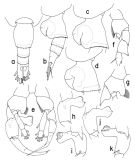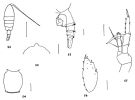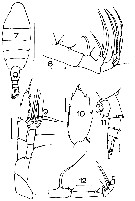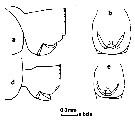|
|
 |
Fiche d'espèce de Copépode |
|
|
Calanoida ( Ordre ) |
|
|
|
Arietelloidea ( Superfamille ) |
|
|
|
Heterorhabdidae ( Famille ) |
|
|
|
Heterorhabdus ( Genre ) |
|
|
| |
Heterorhabdus lobatus Bradford, 1971 (F,M) | |
| | | | | | | Syn.: | Heterorhabdus papilliger : Bradford, 1970 a (p.358, figs.F,M, Rem); 1972 (p.46, figs.F);
Heterorhabdus (Heterorhabdus) lobatus : Bradford-Grieve,1999 b (p.81, figs.F,M, Rem., figs.174, 191) | | | | Ref.: | | | Bradford, 1971 a (p.131, figs.F,M); Bradford-Grieve & al., 1999 (p.883, 944, figs.F,M); Park, 2000 (p.105, figs.F,M, Rem.) |  issued from : T. Park in Bull. Scripps Inst. Oceanogr. Univ. California, San Diego, 2000, 31. [p.226, Fig.74]. Female: a, b, urosome (dorsal, left, respectively); c, genital somite with posteroventral arthrodial membrane folded in (left); d, genital somite with posteroventral arthrodial membrane somewhat extended (left). Male: e, P5 (anterior); f, left P5 (endopod omitted), anterior; g, basipod of right P5 (anterior); h, i, second exopodal segment of right P5 (anterior, posterior, respectively); j, k, second exopodal segment of right P5 from different specimen (anterior, posterior, respectively).
|
 issued from : J.M. Bradford-Grieve in The Marine Fauna of New Zealand: Pelagic Calanoid Copepoda. National Institute of Water and Atmospheric Research (NIWA). NIWA Biodiversity Memoir, 111, 1999. [p.81, Fig.48]. Female: A, genital somite (right lateral side); B, idem (dorsal); C, genital somite (right lateral side); D, exopod segment 3 of P5; E, endopod of P5; F, Mxp. Male: G, P5.
|
 issued from : J.M. Bradford in N.Z. Jl Mar. Freshw. Res., 1970, 4 (4). [p.359, Figs 52-57]. Female (off Kaikoura, New Zealand): 52, habitus (dorsal); 53, forehead (dorsal); 54, genital segment dorsal); 55, urosome (lateral left side); 56, 3rd exopod of P3; 57, P5. ( Scale bars represent 0.1 mm.
|
 issued from : J.M. Bradford in N.Z. Jl Mar. Freshw. Res., 1970, 4 (4). [p359., Figs 58-59]. Male (off Kaikoura, New Zealand): 58, P5; 59, internal protrusion on 2nd exopod of right P5 (this protrusion bears a serrated projection). Scale bars represent 0.1 mm.
|
 issued from : J.M. Bradford in Mem. N. Z. Oceonogr. Inst., 1972, 54. [p.47, Fig.12, (7-12]. As Heterorhabdus papilliger. Female (from Kaikoura, New Zealand): 7, habitus (dorsal); 8, Mx2; 9, P5; 10, P3 (exopod segment 3); 11, urosome (lateral);12, Mxp. Scale bars: 1 mm (7); 0.1 mm (8-12).
|
 issued from : J.M. Bradford in N.Z. Jl mar. freshw. Res., 1971, 5 (1). [p.132, Fig.10, a, b, d, e): Comparison between H. lobatus (a, b) and H. papilliger (d, e) females. a, d: genital segment (left side); b, e: ventral view of genital segment.
|
 issued from : J.M. Bradford in N.Z. Jl mar. freshw. Res., 1971, 5 (1). [p.132, Fig.10, a, b, d, e): Comparison between H. lobatus (c) and H. papilliger (f) males. c, f: P5.
|
 Heterorhabdus lobatus Heterorhabdus lobatus female: 1 - See key to species groups of Heterorhabdus: ''papilliger'' Group (p.90, 102). 2 - Midanterior tubercular process of forehead produced into a rounded process and not produced into a spiniform process. P5 without inner marginal seta on 1st endopodal segment. 3 - Laterally, genital prominence extending down to posterior end of somite (Fig.74-b). 4 - Laterally, genital prominence somewhat truncate, with a steep anterior wall making an angle of about 75° with longitudinal axis of somite (Fig.74-b).
|
 Heterorhabdus lobatus Heterorhabdus lobatus male: 1 - See key to species groups of Heterorhabdus: ''papilliger'' Group (p.90, 102). 2 - Medianterior tubercular process of forehead angular and not produced into a spiniform process. Basal inner lobe of left P5 rather poorly developed with angular distally (Fig.74-f). 3 - In right P5, medial projection of 2nd exopodal segment terminally expanded, with a large, rounded lobe (Fig.74-h). 4 - In medial projection of 2nd exopodal segment of right P5, distal lobe more or less rounded and similar in size to proximal lobe (Fig.74-k).
|
 issued from : J.M. Bradford in N.Z. Jl mar. freshw. Res., 1971, 5 (1). [p.133, Table 2): Differences between H. lobatus and H. papilliger.
| | | | | Ref. compl.: | | | Carter, 1977 (1978) (p.36); Ayon & al., 2008 (p.238, Table 4: Peruvian samples); Park & Ferrari, 2009 (p.143, Table 5, Appendix 1, biogeography); Schnack-Schiel & al., 2010 (p.2064, Table 2: E Atlantic subtropical/tropical); Hidalgo & al., 2010 (p.2089, Table 2); Hidalgo & al., 2012 (p.134, Table 2) | | | | NZ: | 8 | | |
|
Carte de distribution de Heterorhabdus lobatus par zones géographiques
|
| | | | | |  Carte de 1996 Carte de 1996 | |
| | | | Loc: | | | South Afica. (E & W), Namibia (in Carola, 1994), SE Atlant., off Mauritania- NW Cape Verde Is. (in Lapernat, 2000, tab.3, 4), South Africa (Natal), S Mozambique, SW Indian, E Pacif. (N-S), Pacif. ( E equatorial), Peru, New Zealand (N & S, Kaikoura), sub-Antarct., Tasman Sea (N & S), Chile (N-S, off Santiago)
Type locality: 42°24.5'S, 174°01.8'E. | | | | N: | 8 | | | | Lg.: | | | (116) F: 2,5; (399) F: 2,6-2,1; M: 2,5-2; (824) F: 2,64-2; M: 2,76-1,92; {F: 2,00-2,64; M: 1,92-2,76} | | | | Rem.: | "Papilliger" Group.
épi-mésopélagique.
Des confusions peuvent exister entre cette espèce et H. papilliger.
Voir aussi les remarques en anglais | | | Dernière mise à jour : 22/09/2015 | |
|
|
 Toute utilisation de ce site pour une publication sera mentionnée avec la référence suivante : Toute utilisation de ce site pour une publication sera mentionnée avec la référence suivante :
Razouls C., Desreumaux N., Kouwenberg J. et de Bovée F., 2005-2025. - Biodiversité des Copépodes planctoniques marins (morphologie, répartition géographique et données biologiques). Sorbonne Université, CNRS. Disponible sur http://copepodes.obs-banyuls.fr [Accédé le 03 juillet 2025] © copyright 2005-2025 Sorbonne Université, CNRS
|
|
 |
 |










